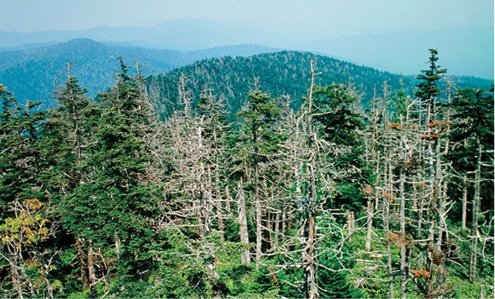
“Acid rain” is a well known term that refers to the deposition of moist (rain, snow, sleet, fog, cloud water, and dew) and dry (acidifying particles and gases) acidic components. It lies among the most damaging environmental factors and has a wide range of its victims. Once carbon dioxide is removed from distilled water, it will have a neutral pH of 7 while pH more or less than 7 refers to acidic and alkaline liquids, respectively. The pH of “clean” or unpolluted rain is acidic, but not less than 5.7, as water and carbon dioxide in the air react to form carbonic acid, a weak acid. The oxides of nitrogen and sulphur are responsible for lowering the pH of rain to such an acidic nature that becomes a threat for the biodiversity and human infrastructure. Such rain is referred to be as “Acid Rain”.
The ecological effects of acid rain are most visible in the aquatic environments, such as streams, marshes and lakes. Acid rain flows into streams, marshes, and lakes after its fall on forests, fields, buildings and roads. Acid rain also falls directly on aquatic habitats. The pH of most of the lakes and streams has a range between 6 and 8, although some lakes naturally have acidic contents. Furthermore, when the water itself and its surrounding soil cannot buffer the acid rain enough to neutralize it then this is the place where acid rain affects lakes and streams, as a result converting their nature to acidic one (i.e., the pH value goes down).
A lot of lakes and streams examined in a National Surface Water Survey (NSWS) uncovered their suffering from chronic acidity, which is a state of constant low pH level. The survey examined the effects of acidic deposition in more than 1,000 lakes larger than 10 acres and in thousands of miles of streams believed to be acid sensitive. Acid rain caused acidity in 75 per cent of the examined acidic lakes and about 50 per cent of the acidic streams.
Moreover, it is a cause of cascade of effects that kill individual fish, lessen fish population, totally eliminate fish species from a water body, and reduce biodiversity. When acid rain flows via soils in a watershed, aluminum is leached out from soils into the lakes and streams present in that watershed. So, the aluminum levels increase with a decline in the pH of lakes and streams. Both low pH and enhanced aluminum levels are damaging for fish. In addition, low pH and enhanced aluminum levels are a cause of chronic stress that leads to lower body weight and smaller size and make fish incapable to compete for habitat and food.
Some of the plants and animals are capable to withstand acidic waters. Others, however, are incapable of this and will be lost as the pH declines. Generally, the infants of most aquatic species are more sensitive to environmental fluctuations than adults. Most fish eggs cannot hatch at pH 5. Some adult fish die at lower pH levels. Some acid lakes have no fish. The chart given below displays that all fish, shellfish, or the insects that they eat cant withstand the same amount of acid; e.g, frogs can more withstand water that has a lower pH than trout.
Not only the aquatic life but also the terrestrial (grassland, forest and agro-ecosystems) are vulnerable to acid rain. By understanding its mode of action it clarifies that it does not wipe out trees directly, it actually weakens the trees by affecting their leaves, reducing the nutrients available to them, or exposure to harmful substances gradually released from the soil. The injury or death of trees is a consequence of these effects of acid rain in combination with one or more conjoint threats. Scientists are aware of the fact that acidic water dissolves the nutrients and necessary minerals in the soil and then washes them off before trees and other plants can utilize them to grow. At the same time, acid rain is a cause of leaching of substances that are harmful to trees and plants, such as aluminum, into the soil. Scientists have a firm belief that this combination of soil nutrients loss and toxic aluminum enhancement may be one way that acid rain damages the trees. The trees can also be damaged even if the soil is well buffered.
Moreover, acid rain damages stone primarily by two methods: dissolution and alteration. The dissolution of calcite present in the marble and limestone takes place when it reacts with sulfurous, sulfuric and nitric acids in polluted air. We see roughened surfaces, material removal, and loss of carved details in bared areas of buildings and statues. Stone surface material may be totally lost or only in spots that are more reactive.
But how can we minimize the lethal effects of acid rain is the question that came into the mind of every man who is a part of this earth. Threats of fall of acid rain can be reduced by educating the people about lesser usage of acidic materials, promoting forest plantation, rubbish should not be burnt as it produces the most dangerous gases that make up the acid rain, consumption of fuel and oil from industries should be reduced, use an alternative energy source such as batteries, solar and wind power electricity, conservation of electricity should be promoted to stop the burning of high sulfur coal, travelling by bus should be promoted rather than driving a bike or car. In the end we should walk more and drive less.
Remedies for avoiding this damage are easier to perform. So, public should be well educated through electronic and print media about its harmfulness and remedies in order to overcome this problem.
The authors are associated with the Department of Botany and Agronomy, University of Agriculture, Faisalabad, Pakistan.